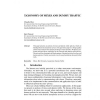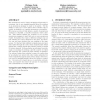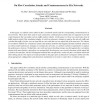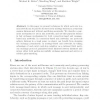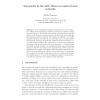99
Voted
IFIP11
2004
15 years 1 months ago
2004
This paper presents an analysis of mixes and dummy traffic policies, which are building blocks of anonymous services. The goal of the paper is to bring together all the issues rela...
116
Voted
CCS
2009
ACM
15 years 4 months ago
2009
ACM
This work casts the traffic analysis of anonymity systems, and in particular mix networks, in the context of Bayesian inference. A generative probabilistic model of mix network ar...
92
Voted
ACSAC
2000
IEEE
15 years 5 months ago
2000
IEEE
Early IT security evaluation criteria like the TCSEC and the ITSEC suffered much criticism for their lack of coverage of privacy-related requirements. Recent evaluation criteria, ...
98
Voted
WPES
2003
ACM
15 years 5 months ago
2003
ACM
Mix networks are used to deliver messages anonymously to recipients, but do not straightforwardly allow the recipient of an anonymous message to reply to its sender. Yet the abili...
114
Voted
PET
2004
Springer
15 years 6 months ago
2004
Springer
In this paper, we address issues related to flow correlation attacks and the corresponding countermeasures in mix networks. Mixes have been used in many anonymous communication s...
102
Voted
ACNS
2005
Springer
15 years 6 months ago
2005
Springer
In this paper we present techniques by which each mix in a mix network can be paid for its services by message senders, in a way that ensures fairness and without sacrificing anon...
123
Voted
WPES
2006
ACM
15 years 6 months ago
2006
ACM
Oblivious submission to anonymity systems is a process by which a message may be submitted in such a way that neither the anonymity network nor a global passive adversary may dete...
110
Voted
PET
2007
Springer
15 years 6 months ago
2007
Springer
Abstract. As decentralized computing scenarios get ever more popular, unstructured topologies are natural candidates to consider running mix networks upon. We consider mix network ...
